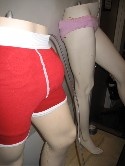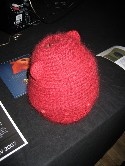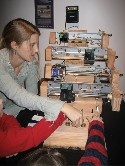2007 NYU Tisch School of the Arts's ITP Winter Show
New York University Students Working With Technology Art Show Off
By: Matthew Belanger - Dec 17, 2007
I recently attended the Interactive Telecommunications Program's (ITP for short) 2007 Winter Show. Twice a year ITP displays the work of student artists experimenting with new technologies. This year's Winter Show was Sunday, December 16 2-6pm and Monday, December 17 5-9pm at 721 Broadway in New York City.
These shows are always a wildly mixed bag consisting of physical computing projects, networked objects, assistive technology devices, live 3-D, audio, and video manipulation, sustainable energy practice, social and participatory media, and that's really just scratching the surface. ITP is a graduate program at New York University's Tisch School of the Arts known as a place where artists, programmers, engineers, and people from all walks of life come together to explore new ways of expressing and informing using emerging technologies.
The focus of ITP has always been on the humans that inevitably use technology and not simply technology for technology's sake. The program was founded in 1979 and grew out of the work of the Alternate Media Center, a non-profit organization, which was founded in 1971 to promote the innovative use of technology for individuals and groups who did not have access to technology such as persons with disabilities, senior citizens, and immigrant populations.
ITP has grown into a world renowned center for creative technology research and use. Many of the projects that come out of the program are influenced by Physical Computing philosophy and practice. P-Comp, as it's generally referred to by those who engage in it, is the use of interactive physical systems that can sense and respond to the analog world we live in. P-Comp projects use sensors, microcontrollers, and software to translate real world input and to control motors, servos, lighting and other objects in the physical world.
P-comp projects combine elements of electrical engineering, networking, robotics, audio, visual and haptic feedback, as well as participation with more traditional sculptural and installation art techniques.
My partner, Marianne R. Petit, and myself are Co-Directors of the Adams based Greylock Arts. We both share a history at ITP. Marianne and I both attended the program at different times and she now teaches there. Much of the art we showcase in our gallery is produced by ITP students and alumni. Marianne and I hope to feature some of the exciting works from this show in upcoming exhibitions at Greylock Arts.
The following is an account of some of the works in the show:Andrew Doro and Rory Nugent'sElectronic Copy (Infrared Detector Cloud). Electronic Copy is a light installation consisting of hundreds of small infrared detecting circuits suspended on wires. In each detector, a warm white LED glows corresponding to the detected amount of infrared light. The viewer is invited to hold an infrared LED to wave around. As the detectors sense more infrared the detector's LED grows in intensity making visible the otherwise invisible light being emitted from the LED in your hand and from your natural surroundings. The subtle beauty of this project is impossible to capture through photography.
Nugent is an artist who has already been featured in two exhibitions at Greylock Arts, Sustainable Energy Art and LEDs Are Pretty.Elim Cheng, Jong Min Kim, and Sangwon Yu's Keep In Touch is a musical installation that encourages users to interact with each other in addition to the installation itself. User's trigger musical instruments by touching triggers mounted to the wall. However, because of the spacing of the triggers, it is impossible for one person to trigger all of the instruments at once.
The user needs to hold hands with several others to create a chain of people long enough to touch the last trigger. This project was the feel good hit of the show because it forced strangers to hold hands and dance to the music. Jaymes Dec and Matthew Fargo's Jabberjockeys consist of a pair of wearable networked undergarments which discreetly inform a wearer when their partner gets aroused. Arousal is detected by measuring subtle changes in temperature, moisture and pressure through embedded sensors. The underwear notifies the partner through a Bluetooth connection with a cell phone by activating vibrating motors sewn into the fabric of their underwear.
This project was demonstrated by pumping a fake erection into a male mannequin's underpants and waiting for the female underpants to vibrate. Needless to say this project was very provocative.
Che-Wei Wang, Eduardo Lytton, and Kristin O'Friel's momo : a haptic navigation device. momo uses GPS, physical gesture, and haptic feedback to guide a user to a destination. momo is a large egg-like "being" that you hold in your hands. It is outfitted with a knitted red sweater / hood that challenges the user's sense of what a high tech device should look like. momo twitches and shifts as you walk around and change course to inform you about which direction you need to go to get to a particular place.
This project was a product of the Introduction to Physical Computing class and it's one of the most advanced things I've seen come out of that introductory class. Andrew Doro and Lesley Flanigan's Plink Jet is a musical instrument constructed from found ink jet printer parts. Ink cartridges and plucking mechanisms play guitar strings by manipulating both pitch and strumming patterns. The instrument is capable of playing itself autonomously, using input from the user through the use of knobs and switches, or in a collaborative performance, between the device itself and the user.
Ana Maria Gutierrez and Raphael Zollinger's disPLACEment that tries to depict how our unconscious daily actions affect events and lives elsewhere. A viewer's silhouette masks a video of the Iraq war being projected onto a screen in a dimly lit room. As the viewer moves throughout the space other parts of the video are revealed leaving the viewer to consider their role in the ongoing war.
For a complete list of works exhibited see the ITP 2007 Winter Show's Project Page.
Matthew Belanger and Marianne R. Petit are the directors and curators of Greylock Arts in Adams, Mass. To learn more about their program log on to







